高中英语教学设计模板
- 格式:doc
- 大小:462.50 KB
- 文档页数:11

高中英语教案模板(通用8篇)高中英语教案模板(通用8篇)作为一位杰出的老师,总不可避免地需要编写教案,借助教案可以让教学工作更科学化。
教案应该怎么写才好呢?以下是小编为大家收集的高中英语教案,希望能够帮助到大家。
高中英语教案篇1一、教学内容分析本单元的中心话题是西方绘画艺术的历史和中西方各种艺术形式和风格。
听说读写都是围绕这个而展开的。
这节课的内容主要是围绕中国的绘画艺术的历史和风格及其各个时期的代表作品而展开的。
通过做听力训练和热身,让他们对艺术和绘画有一个大概的了解,从而为接下来西方艺术的学习垫定基础。
二、教学目标1.aims of knowledge(知识目标)1) to know the information about art2) to know some relevant words and expressions2.aims of abilities(能力目标)1) to improve students listening ability by guessing the content and setting down the key words2) to enable the students to understand the brief short history of the traditional chinese painting3.affective aims(情感、态度与价值观目标)to arouse the patriotic spirit of the students and improve their team spirit by doing the group work三、学习者特征分析虽然这是选修七第一单元的第一个课时,学生在语言理解上会有一定障碍。
我们班学生男生为大多数,普遍听力较薄弱,也比较缺乏兴趣。
但是高二的学生通过一年多的高中英语学习,已经积累了一定的词汇,而且在听听力之前教师会让学生做热身,先熟悉目标词汇,使听力难度降低。
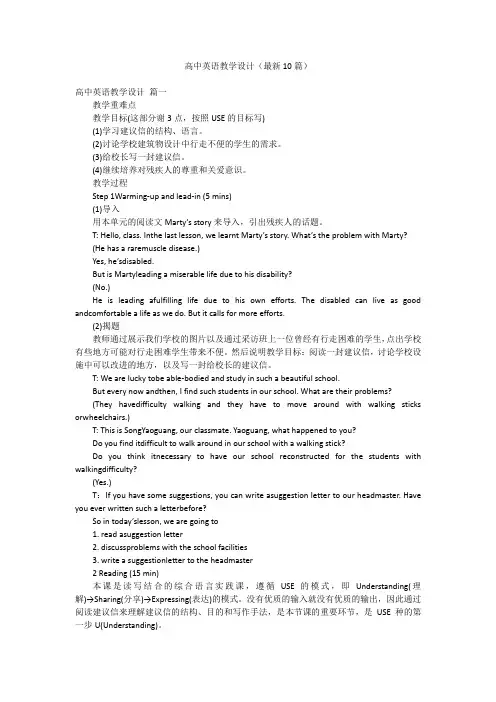
高中英语教学设计(最新10篇)高中英语教学设计篇一教学重难点教学目标(这部分谢3点,按照USE的目标写)(1)学习建议信的结构、语言。
(2)讨论学校建筑物设计中行走不便的学生的需求。
(3)给校长写一封建议信。
(4)继续培养对残疾人的尊重和关爱意识。
教学过程Step 1Warming-up and lead-in (5 mins)(1)导入用本单元的阅读文Marty’s story来导入,引出残疾人的话题。
T: Hello, class. Inthe last lesson, we learnt Marty’s story. What’s the problem with Marty?(He has a raremuscle disease.)Yes, he’sdisabled.But is Martyleading a miserable life due to his disability?(No.)He is leading afulfilling life due to his own efforts. The disabled can live as good andcomfortable a life as we do. But it calls for more efforts.(2)揭题教师通过展示我们学校的图片以及通过采访班上一位曾经有行走困难的学生,点出学校有些地方可能对行走困难学生带来不便。
然后说明教学目标:阅读一封建议信,讨论学校设施中可以改进的地方,以及写一封给校长的建议信。
T: We are lucky tobe able-bodied and study in such a beautiful school.But every now andthen, I find such students in our school. What are their problems?(They havedifficulty walking and they have to move around with walking sticks orwheelchairs.)T: This is SongYaoguang, our classmate. Yaoguang, what happened to you?Do you find itdifficult to walk around in our school with a walking stick?Do you think itnecessary to have our school reconstructed for the students with walkingdifficulty?(Yes.)T:If you have some suggestions, you can write asuggestion letter to our headmaster. Have you ever written such a letterbefore?So in today’slesson, we are going to1. read asuggestion letter2. discussproblems with the school facilities3. write a suggestionletter to the headmaster2 Reading (15 min)本课是读写结合的综合语言实践课,遵循USE的模式,即Understanding(理解)→Sharing(分享)→Expressing(表达)的模式。
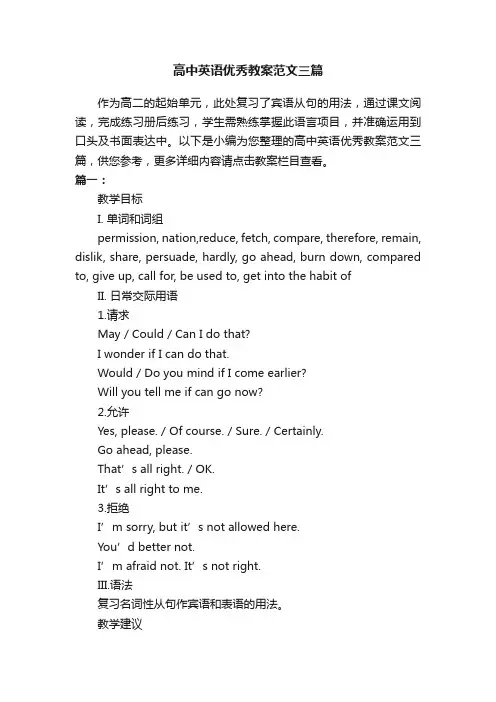
高中英语优秀教案范文三篇作为高二的起始单元,此处复习了宾语从句的用法,通过课文阅读,完成练习册后练习,学生需熟练掌握此语言项目,并准确运用到口头及书面表达中。
以下是小编为您整理的高中英语优秀教案范文三篇,供您参考,更多详细内容请点击教案栏目查看。
篇一:教学目标I. 单词和词组permission, nation,reduce, fetch, compare, therefore, remain, dislik, share, persuade, hardly, go ahead, burn down, compared to, give up, call for, be used to, get into the habit ofII. 日常交际用语1.请求May / Could / Can I do that?I wonder if I can do that.Would / Do you mind if I come earlier?Will you tell me if can go now?2.允许Yes, please. / Of course. / Sure. / Certainly.Go ahead, please.That’s all right. / OK.It’s all right to me.3.拒绝I’m sorry, but it’s not allowed here.You’d better not.I’m afraid not. It’s not right.III.语法复习名词性从句作宾语和表语的用法。
教学建议教材分析The main dialogue of this unit is to practise the students how to ask for permission, refuse and give permission ability. Though learning the way of expressing are able to remind the students speaking in daily life. This dialogue is the main idea to learn to use these phrase for permission. Though two men’s talking. Meanwhile this lesson offer some practice to help the students to understand and learn about the content of the dialogue. In order to master these phases, this lesson has short dialogue to give the students to speak each other.重点词汇讲解1.catch fire与be on fire1)catch fire:begin to burn着火;烧着。
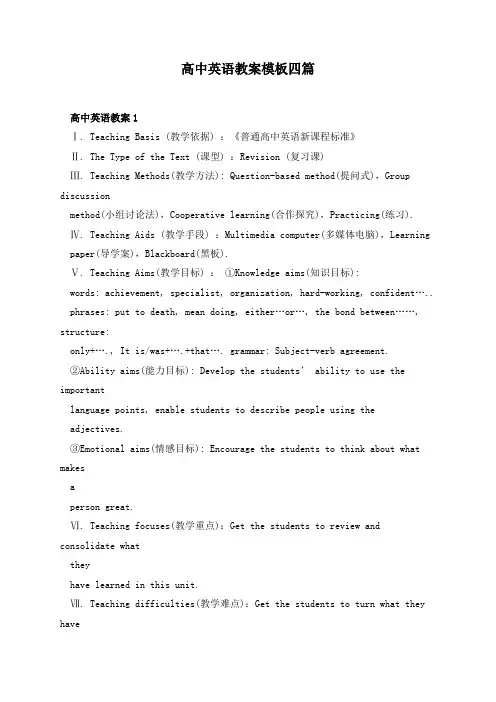
高中英语教案模板四篇高中英语教案1Ⅰ. Teaching Basis (教学依据) :《普通高中英语新课程标准》Ⅱ. The Type of the Text (课型) :Revision (复习课)Ⅲ. Teaching Methods(教学方法): Question-based method(提问式),Group discussionmethod(小组讨论法),Cooperative learning(合作探究),Practicing(练习). Ⅳ. Teaching Aids (教学手段) :Multimedia computer(多媒体电脑),Learning paper(导学案),Blackboard(黑板).Ⅴ. Teaching Aims(教学目标) :①Knowledge aims(知识目标):words: achievement, specialist, organization, hard-working, confident….. phrases: put to death, mean doing, ei ther…or…, the bond between……, structure:only+…., It is/was+….+that…. grammar: Subject-verb agreement.②Ability aims(能力目标): Develop the students’ ability to use the importantlanguage points, enable students to describe people using theadjectives.③Emotional aims(情感目标): Encourage the students to think about what makesaperson great.Ⅵ. Teaching focuses(教学重点):Get the students to review and consolidate whattheyhave learned in this unit.Ⅶ. Teaching difficulties(教学难点):Get the students to turn what they havelearned intotheir ability.Ⅷ.Teaching procedure(教学过程): Step 1 复习学案情况反馈(1分钟)Step 2 lead-in :通过图片展示的方式,过渡到知识竞答类节目《一站到底》,本节课也将模仿这种模式授课。
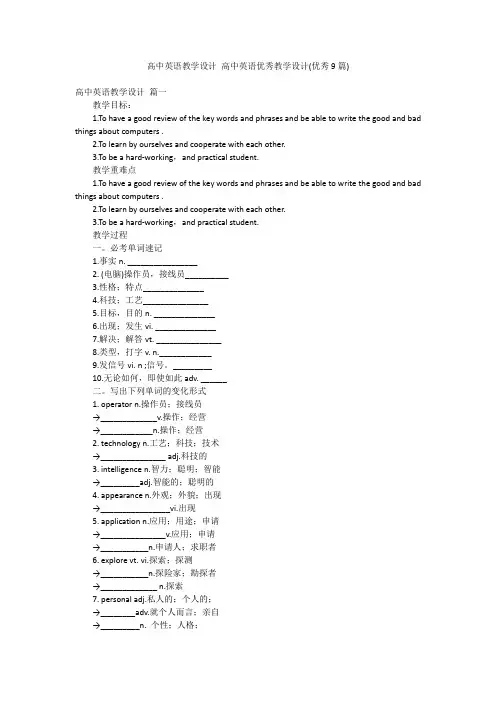
高中英语教学设计高中英语优秀教学设计(优秀9篇)高中英语教学设计篇一教学目标:1.To have a good review of the key words and phrases and be able to write the good and bad things about computers .2.To learn by ourselves and cooperate with each other.3.To be a hard-working,and practical student.教学重难点1.To have a good review of the key words and phrases and be able to write the good and bad things about computers .2.To learn by ourselves and cooperate with each other.3.To be a hard-working,and practical student.教学过程一。
必考单词速记1.事实n. ________________2. (电脑)操作员,接线员__________3.性格;特点______________4.科技;工艺_______________5.目标,目的n. ______________6.出现;发生vi. ______________7.解决;解答vt. _______________8.类型,打字v. n.____________9.发信号vi. n ;信号。
_________10.无论如何,即使如此adv. ______二。
写出下列单词的变化形式1. operator n.操作员;接线员→_____________v.操作;经营→____________n.操作;经营2. technology n.工艺;科技;技术→_______________ adj.科技的3. intelligence n.智力;聪明;智能→_________adj.智能的;聪明的4. appearance n.外观;外貌;出现→________________vi.出现5. application n.应用;用途;申请→_______________v.应用;申请→___________n.申请人;求职者6. explore vt. vi.探索;探测→___________n.探险家;勘探者→_____________ n.探索7. personal adj.私人的;个人的;→________adv.就个人而言;亲自→_________n. 个性;人格;三、用所给词的适当形式填空(1)Can you say dolphins are much more ____________than other animals?Well, they are animals of high _____________. (intelligent)(2) She expressed her _________ opinion yesterday. ____________ speaking, I agreed with what she said. (personal)(3) Any ___________ who would like to _____________ to become anassistant in our company should send us an ___________ .(apply)四、语境助记——词不离句,句不离段With the electronic technology revolution going on,simplified calculation is solved in the application on finance by universal exploration. Our goal of making life happier is certain to be realized through man's intelligence.五、翻译下列必背短语?1.在某种程度上_______________2.依…看;据…认为_____________3.从…时候起_______________4.结果_______________5.处理;安排;对付____________6.弥补,补足;整理,编造_________7.毕竟_______________?8.看守,监视_______________9.在……帮助下_______________?六。
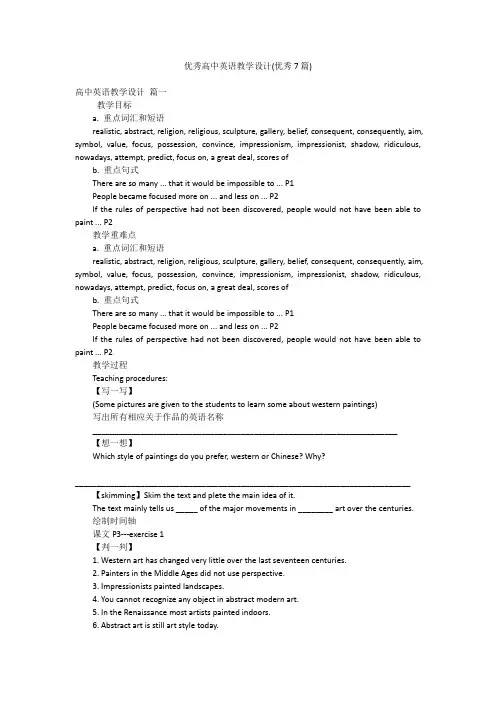
优秀高中英语教学设计(优秀7篇)高中英语教学设计篇一教学目标a. 重点词汇和短语realistic, abstract, religion, religious, sculpture, gallery, belief, consequent, consequently, aim, symbol, value, focus, possession, convince, impressionism, impressionist, shadow, ridiculous, nowadays, attempt, predict, focus on, a great deal, scores ofb. 重点句式There are so many ... that it would be impossible to ... P1People became focused more on ... and less on ... P2If the rules of perspective had not been discovered, people would not have been able to paint ... P2教学重难点a. 重点词汇和短语realistic, abstract, religion, religious, sculpture, gallery, belief, consequent, consequently, aim, symbol, value, focus, possession, convince, impressionism, impressionist, shadow, ridiculous, nowadays, attempt, predict, focus on, a great deal, scores ofb. 重点句式There are so many ... that it would be impossible to ... P1People became focused more on ... and less on ... P2If the rules of perspective had not been discovered, people would not have been able to paint ... P2教学过程Teaching procedures:【写一写】(Some pictures are given to the students to learn some about western paintings)写出所有相应关于作品的英语名称______________________________________________________________________【想一想】Which style of paintings do you prefer, western or Chinese? Why?_____________________________________________________________________________ 【skimming】Skim the text and plete the main idea of it.The text mainly tells us _____ of the major movements in ________ art over the centuries.绘制时间轴课文P3---exercise 1【判一判】1. Western art has changed very little over the last seventeen centuries.2. Painters in the Middle Ages did not use perspective.3. Impressionists painted landscapes.4. You cannot recognize any object in abstract modern art.5. In the Renaissance most artists painted indoors.6. Abstract art is still art style today.【选一选】Choose the best answer.1. According to the text, art is least influenced by ________.A. social changesB. the way of lifeC. the development of agricultureD. beliefs of a people2. When did painters mainly focus more on people and less on religion?A. From 5th to 壹五th century AD.B. From 壹五th to 16th century.C. From late 19th to early 20th century.D. From 20th century to today.3. Who were the first to paint outdoors?A. Painters in the Middle Ages.B. Painters in the Renaissance.C. The Impressionists.D. Contemporary painters.【巩固训练】讲练通---P2 retelling课后习题【Homework】课时跟踪训练(7)To say No good! / Terrible!(8)To mean thinking or “worrying”。
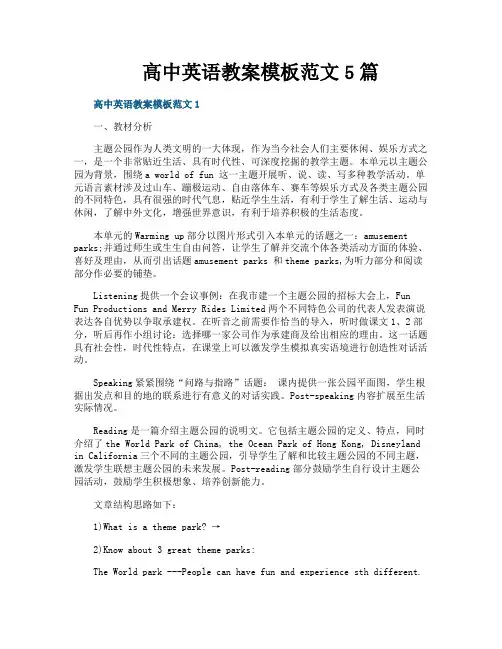
高中英语教案模板范文5篇高中英语教案模板范文1一、教材分析主题公园作为人类文明的一大体现,作为当今社会人们主要休闲、娱乐方式之一,是一个非常贴近生活、具有时代性、可深度挖掘的教学主题。
本单元以主题公园为背景,围绕a world of fun 这一主题开展听、说、读、写多种教学活动。
单元语言素材涉及过山车、蹦极运动、自由落体车、赛车等娱乐方式及各类主题公园的不同特色,具有很强的时代气息,贴近学生生活,有利于学生了解生活、运动与休闲,了解中外文化,增强世界意识,有利于培养积极的生活态度。
本单元的Warming up部分以图片形式引入本单元的话题之一:amusement parks;并通过师生或生生自由问答,让学生了解并交流个体各类活动方面的体验、喜好及理由,从而引出话题amusement parks 和theme parks,为听力部分和阅读部分作必要的铺垫。
Listening提供一个会议事例:在我市建一个主题公园的招标大会上,Fun Fun Productions and Merry Rides Limited两个不同特色公司的代表人发表演说表达各自优势以争取承建权。
在听音之前需要作恰当的导入,听时做课文1、2部分,听后再作小组讨论:选择哪一家公司作为承建商及给出相应的理由。
这一话题具有社会性,时代性特点,在课堂上可以激发学生模拟真实语境进行创造性对话活动。
Speaking紧紧围绕“问路与指路”话题:课内提供一张公园平面图,学生根据出发点和目的地的联系进行有意义的对话实践。
Post-speaking内容扩展至生活实际情况。
Reading是一篇介绍主题公园的说明文。
它包括主题公园的定义、特点,同时介绍了the World Park of China, the Ocean Park of Hong Kong, Disneyland in California三个不同的主题公园,引导学生了解和比较主题公园的不同主题,激发学生联想主题公园的未来发展。

高中英语教学设计优秀7篇高中英语教学设计篇一教学目标1.引导学生通过上下文理解生词的含义:anecdote, annual, witness, accommodation, shore, yell, pack, flee, drag, depth, lip, tongue, abandon, relationship, help out2.帮助学生掌握文中一些描述事物和情景的生动手法,从而体会作者的思想情感,把握文章的精髓。
3.帮助学生通过两个故事,对生活在大洋的虎鲸能有更多的了解,同时对虎鲸给予我们人类忠实的帮助产生由衷的感激,从而加强动物保护和环境保护意识。
教学重难点1.引导学生通过上下文理解生词的含义:anecdote, annual, witness, accommodation, shore, yell, pack, flee, drag, depth, lip, tongue, abandon, relationship, help out2.帮助学生掌握文中一些描述事物和情景的生动手法,从而体会作者的思想情感,把握文章的精髓。
3帮助学生通过两个故事,对生活在大洋的虎鲸能有更多的了解,同时对虎鲸给予我们人类忠实的帮助产生由衷的感激,从而加强动物保护和环境保护意识。
教学过程Step1 Lead –in amp;Warming-up(5mins)问题导入——教师呈现问题和图片T: Have you seen plants andanimals that live under the sea? Where did you see them? What’s this? Yes,they’re killer whales. How much do you know about them? I’ll show you a shortvideo.意图说明:在读前这个环节,通过几个问题,激发学生原有的对海洋生物的知识储备,再展示一些相关的图片,认识一些常见海底动物的英文名称。
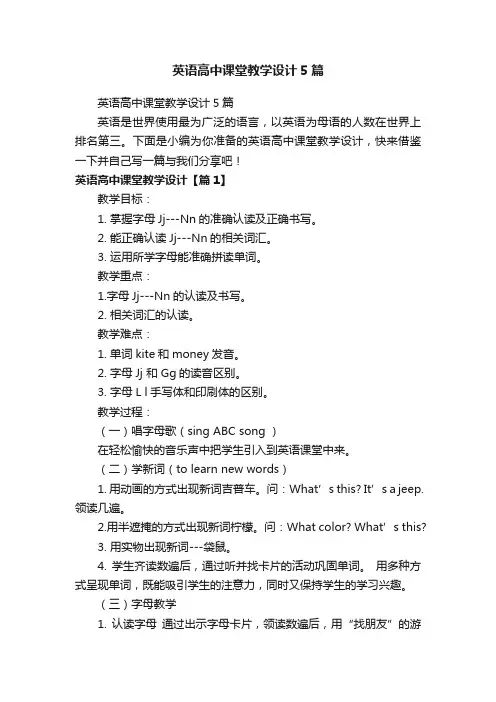
英语高中课堂教学设计5篇英语高中课堂教学设计5篇英语是世界使用最为广泛的语言,以英语为母语的人数在世界上排名第三。
下面是小编为你准备的英语高中课堂教学设计,快来借鉴一下并自己写一篇与我们分享吧!英语高中课堂教学设计【篇1】教学目标:1. 掌握字母Jj---Nn的准确认读及正确书写。
2. 能正确认读Jj---Nn的相关词汇。
3. 运用所学字母能准确拼读单词。
教学重点:1.字母Jj---Nn的认读及书写。
2. 相关词汇的认读。
教学难点:1. 单词kite和money发音。
2. 字母Jj 和 Gg的读音区别。
3. 字母L l手写体和印刷体的区别。
教学过程:(一)唱字母歌(sing ABC song )在轻松愉快的音乐声中把学生引入到英语课堂中来。
(二)学新词(to learn new words)1. 用动画的方式出现新词吉普车。
问:What’s this? It’s a jeep. 领读几遍。
2.用半遮掩的方式出现新词柠檬。
问:What color? What’s this?3. 用实物出现新词---袋鼠。
4. 学生齐读数遍后,通过听并找卡片的活动巩固单词。
用多种方式呈现单词,既能吸引学生的注意力,同时又保持学生的学习兴趣。
(三)字母教学1. 认读字母通过出示字母卡片,领读数遍后,用“找朋友”的游戏巩固字母大小写。
既:老师把所学字母卡片的大小写分别发给学生,在听到教师“let’s go”的指令下,学生快速跑到前面并找到自己相应的大小写字母站好。
2. 融会贯通当学生找好相应的大小写字母并站好后,坐在位子上的学生一齐问:“What’s your name ?拿着卡片的学生答:My name is Jj /Kk/Ll……(本册书第一单元的重点句)。
教师任意指着一个字母问:Who’s this/that?学生答:This is Jj/Kk...(本单元重点句)把所学句型应用到字母教学中来,既为枯燥的字母教学创设了语言环境,同时又让学生体会到了语言的灵活性,让他们把所学知识得到了具体的应用。
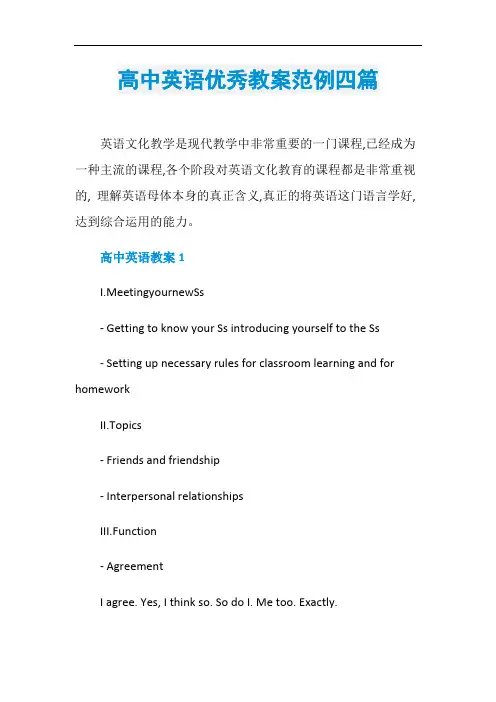
高中英语优秀教案范例四篇英语文化教学是现代教学中非常重要的一门课程,已经成为一种主流的课程,各个阶段对英语文化教育的课程都是非常重视的, 理解英语母体本身的真正含义,真正的将英语这门语言学好,达到综合运用的能力。
高中英语教案1I.MeetingyournewSs- Getting to know your Ss introducing yourself to the Ss- Setting up necessary rules for classroom learning and for homeworkII.Topics- Friends and friendship- Interpersonal relationshipsIII.Function- AgreementI agree. Yes, I think so. So do I. Me too. Exactly.No problem. Sure.Certainly. Of course. All right.You’re right/correct. Good idea.I think that’s a good idea.- DisagreementI don’t think so. Neither do I. That’s not right.Yes, but …I’m afraid not. No way.I’m sorry, but I don’t agree.Of course not. I disagree.IV.Grammar- Direct Speech and Indirect Speech (Part I. Statements and questions)1. Reporting statements“I don’t want to set down a series of facts in a diary,” said Anne.---- Anne said that she didn’t want to set down a series of facts in a diary.2. Reporting yes-no questions“Does a friend always have to be a person?” the writer asks us.---- The writer asks us if a friend always has to be a person.3. Reporting wh- questions“What do you call your diary?” Anne’s sister asked her.---- Anne’s sister asked her what she called her diary.V.Wordsandexpressionsupset ignore calm concern loose Netherlands German series outdoors dusk thunder entire entirely power curtain dusty partner settle suffer highway recover pack suitcase overcoat teenager exactly disagree grateful dislike tip swap item (32 words) add up calm down have got to be concerned aboutwalk the dog go through set down a series ofon purpose in order to at dusk face to faceno longer suffer fromget/be tired ofpack sth. upget along with fall in love join in(19 phrases)- survey vet Amsterdam Jewish Nazi Kitty spellbind loneliness Margot gossip secondly (11 words)VI.Timeallotment1st period – Warming up (P1) Workbook Listening (P41)2nd period –Pre-reading Reading Comprehension (P2-P3)3rd 4th period –Learning about Language (P4-5)5th period –Using Language (P6 Reading listening)6th period–Using Language (P7 Reading Writing)7th period–Wb Listening Task Reading Task (P43-44)8th period–Writing Task Project (P46-47)The 1st period – Warming up Using languageGoals for the 1st period:1. Introduce yourself and set up some rules for learning2. Talk about friends and friendship3. Learn the new words and expressions:upset ignore calm concern loose add up calm down have got to be concerned about walk the dogTeaching procedures:Step1Beginning1. Introduce yourself2. Set up some rules for learning:Before class: 1) Get into the classroom at the first bell.2) Get everything and yourself ready for the class.In class: 1) Follow the teacher closely and work with your mind.2) Take an active part in classroom learning activities.3) Take notes and raise questions.4) Speak English as much as you can.After class: 1) Finish your homework on time and hand it in as required.2) Review what you’ve learned in class in time.3) Preview your lesson as required.Step2Warmingup1. Introduce the topic Friendship. Ask Ss if they have a very good friend and why he or she can be their good friends.(Collect the adjectives/nouns Ss use to describe their friends on the Bb.)Supplements:Poem 1 Friends Poem 2 Auld Lang SyneBy Jill EgglestonBy Robert BurnsFriends care Should auld acquaintance be forgotFriends share and never brought to mind?We need friends Should auld acquaintance be forgotEverywhere!and days of auld lang syne?For auld lang syne, my dear,Proverbs: for auld lang syne,A life without a friend is a life withoutwe’ll take a cup of kindness yes,a sun. --- French proverbfor auld lang syne.You can buy friendship with friendship,but never with dollars.Should auld acquaintance be forgot --- Unknown and never brought to mind?A friend is a person with whom I may be Should auld acquaintance be forgotsincere. With him, I may think aloud. and days of auld lang syne?--- Ralph Waldo Emerson And here’s a hand, my trusty friendReal friendship is shown in times of trouble; And gie’s (give us) a hand o’thineProsperity is full of friends. We’ll tak’ a cup o’kindness yet---EuripidesFor auld lang syne.2. Think: What qualities and behaviors make a good friend?(a. Let the Ss make a list of 3-5 qualities a good friend should have.b. Have them work in group of four to collect the list of words.c. Then ask one from each group to write the words on the Bb.)3. Have the Ss do the survey in the Sb P1.4. When they have completed it, have Ss look again at the list on the Bb to see whether it should be revised.Explanation of each item:Q1: A: 1 point B. 3 points C. 2 pointsThis question deals with how thoughtful you are towards others: How much do you value your friend? Would you change the time of the day to go to the cinema to fit in with him/her?Q2: A: 1 point B. 2 points C. 3 pointsThis question is concerned with fairness: Is it fair for your friend to borrow something, break it and return it broken?Q3: A: 1 point B. 2 points C. 3 pointsThis question deals with your concern for others: Should you make the troubles of your friend more important than your own responsibilities?Q4: A: 3 point B. 2 points C. 1 pointsThis question is concerned with responsibilities to a friend. If you are asked to look after something and it is broken or harmed, what should you do?Q5: A: 0 point B. 2 points C. 0 pointsThis question is concerned with honesty.5. Quickly deal with the meaning of the new expressions in this part. We’ll later practice them in Ex 1, 2, 3 in Learning about language on Sb P.41) add up: v. to add sth. together2) upset: adj. sad, unhappy3) ignore: v. pay no attention to4) calm…down: v. make sb. calm, comfort sb.5) have got to …: v. have to do sth.6) be concerned about: v. be worried about, care about7) walk the dog: v. exercise the dog8) loose: adj. not tight重点词汇用法的学习,例如:1. add: add ... to;add to; add up; add up to;Eg. Will you please add some milk to my coffee?The little baby adds to our enjoyment at the party.Add up your score and see how many points you get.Add up these figures foe me, please.All the money I have in my pocket adds up to $ 125.2. upset: adj. worried, annoyed; v. cause to worry, to be sad/angryEg. I was very upset because one of my friends was rude to me.His cheating in the exam upset his teacher.3. ignore: v. pay no attention to; to behave as if you had not heard or seen sb./sth. n. ignoranceEg. You can’t ignore the fact that many criminals never go to prison.These are the problems which we can’t afford to ignore.Sam rudely ignored the inquiry.He had completely ignored her remark, preferring his own theory.4. calm: v. calm downEg. The mother calmed the baby by giving him some milk.What the manager said calmed the fears of the works.We tried to calm him down, but he kept shouting and crying.Calm down. There’s nothing to worry about.5. concern: v. concern sth.; be concerned about /with/ for sb. / sth.; n.Eg. This case concerns the group of people greatly.What I said at the meeting doesn’t concern you, so don’t worry about it.Our head teacher is concerned about our study and health all the time.He has never been concerned about/for what others think of him.He seemed to be concerned with the case.Your school work, rather than your private life, is my concern.My greatest concern is the development of our school.6. walk the dog: to take a dog for a walkEg. He is out walking the dog.walk sb home/ to a placeIt’s late --- let me walk you to the bus stop.6. If necessary, the T may ask one or two Ss the following questions:a. What kind of person are you according to the survey?b. Do you think you can be a good friend to others? And how?c. What do you think are the basic elements we need to keep our friendship?Step3ListeningWorkbook Listening on P411. Before you listen, discuss these questions with the class.1) Do you think it is a good idea to make friends with people from other countries?(to broaden one’s world outlook; to avoid national stereotypes etc.)2) What are the advantages of this friendship?(to practice another language with a native speaker; to learn new ideas and new ways of thinking; to find out more about another country etc.)2. the 1st Listening of Part 1: Write down what Leslie does in China in one sentence.(Leslie does some business in China and her company sells buses.)3. the 2nd Listening of Part 1: Tick the things done by Leslie.(going out for delicious dinners; visiting a mountain; going to people’s homes)4. the 1st Listening of Part 2: What does Leslie say about the friends she made in China?(1) Leslie says that she make friends but they are just business friends because she thinks one cannot make friends on a short visit.(2) Leslie thinks some of the friends in China may have liked her, but others may try to be nice to her so as to gain a business advantage.Step4Homework1. Make sentences with the 8 new words and expressions.2. Prepare and read aloud the rest new words.The 2nd period – Pre-reading Reading ComprehensionGoals for the 2nd period:1. Have Ss read the text and try their best to understand Anne’s eagerness for friends, friendship, nature and freedom.2. Get Ss have some knowledge about the Nazi’s cruel deeds towards the Jews during the Second World War.3. Train Ss’ reading ability of scanning and skimming. Learn to appreciate Anne’s Diary , the classic work.高中英语教案2课题:Friendship\(2)教材分析与学生分析:本单元的中心话题是“友谊”,几乎所有的内容都是围绕这一中心话题展开的。

高中英语教学设计模板5篇通过学习,能听懂会说六十个单词和二十个短语句子。
培养学生听、说、读、写的能力。
鼓励学生大胆开口,联系生活实际创设情景。
下面是小编为您收集整理的高中英语教学设计模板,希望对您有所帮助。
高中英语教学设计模板1一、教材分析:本课是结合人教版高中英语教材选修5中有关过去分词的语法内容,进行过去分词的学习,教学中将语法知识的传授和语言基本技能的学习结合到一起,注重复习语法与语言的运用。
采用任务型教学法和小组合作探究学习法,从而扩大课堂的语言输入量及学生的语言输出量。
二、学情分析:在高一英语学习基础上,学生已经掌握基本的语言结构和一定程度的听说读写能力。
在复习的过程中,结合学生原有的知识掌握水平,巩固基础强化正确使用语法知识,提高学生运用语言的深度和难度.但大部分学生的基础知识仍然较为薄弱,运用英语进行交际活动的能力较差,主动学习的动力不够,然而他们学习比较认真,渴求知欲旺盛,思维比较活跃。
部分学生的基础较好,能主动配合老师。
只有设置使他们感兴趣的活动,因材施教,才能让他们投入到课堂活动中来。
三、教学目标:1.知识目标:引导学生掌握过去分词在真实的生活语境中的使用。
培养学生通读,分析,理解,综合的能力,教会学生体察语境,结合上下文,符和逻辑推理和合理的想象,结合语法和题干中的语境解决问题。
在运用语言过程中培养学生的观察力、分析力、想象力和自学能力,提高思维能力和运用英语的综合能力。
2.能力目标:利用多媒体手段营造积极和谐教学氛围,使学生进入情景之中,充分调动学生的思维活动和情感体验,规范学生运用英语知识准确表达的能力,同时,发展学生综合语言运用的能力,分析问题和解决问题的能力,培养学生自主学习。
3.德育目标:用含过去分词的句子结构表达思想感情。
四、教学重点:1.过去分词的用法.2. 过去分词的运用五、教学难点:1.结合语法知识,以课堂教学为依托,全面训练学生的听、说、读、写能力,加强和提高运用英语的综合能力。
高中英语优秀教学设计5篇教学设计一:阅读理解策略教学目标:1. 学生能够运用预测、略读、寻读等阅读策略提高阅读效率。
2. 学生能够准确理解文章主旨大意,并能识别文章中的细节信息。
3. 学生能够分析作者的观点和态度,并进行批判性思考。
教学步骤:1. 导入:通过讨论学生感兴趣的话题引入阅读材料,激发学生的阅读兴趣。
2. 略读:指导学生快速浏览文章,了解文章的大致结构和内容。
3. 寻读:引导学生根据问题寻找文章中的关键信息,提高寻找信息的速度和准确性。
4. 精读:组织学生仔细阅读文章,理解文章的细节信息,并分析作者的观点和态度。
5. 讨论:组织学生就文章内容进行讨论,分享自己的观点和感受,培养学生的批判性思维能力。
教学反思:本节课通过引导学生运用阅读策略,提高了学生的阅读效率和理解能力。
在今后的教学中,可以进一步引导学生将阅读策略应用于其他类型的文本,以提高学生的综合阅读能力。
教学设计二:写作技巧训练教学目标:1. 学生能够掌握议论文的基本结构和写作技巧。
2. 学生能够运用论据和论点进行有效的论证。
3. 学生能够进行自我修改和同伴互评,提高写作水平。
教学步骤:1. 导入:通过分析优秀议论文,引导学生了解议论文的基本结构和写作技巧。
2. 写作指导:讲解议论文的写作步骤,包括确定论点、寻找论据、组织文章结构等。
3. 实践练习:组织学生进行写作练习,并鼓励学生运用所学技巧进行创作。
4. 同伴互评:引导学生进行同伴互评,互相提出修改建议,提高写作水平。
5. 自我修改:指导学生根据同伴互评和自我反思进行修改,完善文章。
6. 展示与分享:组织学生展示自己的作品,并分享写作心得和体会。
教学反思:本节课通过讲解写作技巧和实践练习,提高了学生的写作能力。
在今后的教学中,可以进一步引导学生关注写作过程中的细节问题,如语法、拼写、标点等,以提高学生的写作质量。
教学设计三:口语交际能力提升教学目标:1. 学生能够运用恰当的口语表达技巧进行日常交流。
英语教案高中教学范文5篇英语(English)是印欧语系-日耳曼语族下的语言,由26个字母组成,英文字母渊源于拉丁字母,拉丁字母渊源于希腊字母,而希腊字母则是由腓尼基字母演变而来的。
接下来是小编为大家整理的英语教案高中教学范文,希望大家喜欢!英语教案高中教学范文一《Unit 1 Friendship》大家好!今天我说课的内容是高一英语新课程实验教科书必修1 Unit One, The first period。
下面我就从教材分析、教法分析、学法分析、教学过程、教学评价五个方面进行说明。
一、教材分析(一)教材的地位和作用本节课是本单元以及本教材的第一节课,本课谈论的是:朋友是不是仅限于人类、朋友的真正含义、如何与人相处的问题等关于朋友的话题。
本课涉及的有陈述句和疑问句的直接引语和间接引语的掌握和运用等语法要点。
学生从初中到高中,来到一个新的学校,同学彼此陌生,不免想起老同学,老朋友。
这样的话题正好能引起学生的兴趣。
而且本课的内容和语法的启发性和实用性都很强,能使学生在学中用,在用中学,对综合提高学生的听说读写能力有较好的促进作用。
(二)教学目标英语教学大纲规定,通过听说读写的训练,使学生获得英语基础知识和运用英语的能力,激发学生的学习兴趣,为进一步学习打下良好的基础。
因此,我制定以下教学目标:知识目标:1、掌握和使用陈述句和疑问句的直接引语和间接引语。
2、讨论朋友和友谊。
3、学习掌握本课的重点词汇。
技能目标:1、学会阅读的技能——scanningand skimming 。
2、通过谈论朋友和友谊,既锻炼学生的语言运用能力,又培养了学生发现问题、思考问题、解决问题的能力。
3、理解阅读文段,复述故事。
情感态度:1、患难之交才是真朋友。
2、知音难得。
3、海内存知己,天涯若比邻。
文化意识:认识德国纳粹党。
让学生了解那段德国法西斯残害犹太人的历史,使学生在感受外国历史文化的同时自然而然的习得语言。
(三)重点与难点重点:1、训练scanningand skimming等阅读技能。
高中英语优秀教学设计(通用5篇)作为一名专为他人授业解惑的人民教师,通常需要准备好一份教学设计,教学设计是实现教学目标的计划性和决策性活动。
教学设计应该怎么写呢?下面是小编为大家整理的高中英语优秀教学设计(通用5篇),欢迎阅读与收藏。
高中英语优秀教学设计1教学目标知识与技能目标1. Get students to learn some useful new words and expressions in this part.2. Get students to read the letter.3. Let students learn the prohibition, warning and permission.过程与方法目标1. Develop students’ reading skills and enable them to learn how to use different reading strategies to read different reading materials.2. Enable student s to understand how to give advice.情感态度与价值观目标1. Stimulate students’ interests of learning English by reading and acting this play.2. Develop students’ sense of group cooperation and teamwork.教学重点1.state the main idea of each paragraph in own words2.ways to become addicted to cigarettes3.the harmful effects of smoking4. suggestions to quit smoking教学难点1. sorting out major idea and minor idea2. master key words in key sentence教学过程→Step 1 Warming upShow some proverbs on health1.An apple a day keeps the doctor away.2.Early to bed and early to rise, makes a man healthy, wealthy and wise.→Step 2 Skimming1How many parts does the reading text consist of?2. Who wrote the letter to whom?3. How many ways can a man become addicted to smoking?→Step 3 Scanning1. The first sentence of the letter shows James granddad______ .A. lives a healthy lifeB. is addicted to sitting in the gardenC. has nothing to do at homeD. is tired when cycling 20 kilometers2. From the second paragraph, we can know granddad ______________.A . never smoked B. likes smokingC. used to smoke heavilyD. still smokes now→Step 4 Detailed readingAsk students to discuss the following questions in pairs.(让学生分组讨论,形成书面形式)1.Different ways people can become addicted to cigarettes.2. Harmful effects for smokers吸烟的危害3.ways to quit smoking→Step 5 Post readingWrite some advice to persuade smokers to quit smoking→Step6 DiscussionHow to live a healthy life?→Step 7 Homework1. write down the suggestions given by granddad2. try to persuade one to give up smoking高中英语优秀教学设计2一、说教材本单元主要是围绕生日展开教学,要求学生掌握十二个月份和序数词的变化,以及日期和生日的表达。
2022年高中英语教案模板通用6篇英语是印欧语系-日耳曼语族下的语言,由26个字母组成,英文字母渊源于拉丁字母,拉丁字母渊源于希腊字母,而希腊字母则是由腓尼基字母演变而来的。
下面是由编辑为大家整理的“2022年高中英语教案模板通用6篇”,仅供参考,欢迎大家阅读本文。
篇一:2022年高中英语教案模板通用教学准备教学目标1、学生能通过寻找每段的主题句归纳文章结构。
2、学生能够通过在课文中寻找相关表述感知作者态度。
3、学生能够基于文本信息和话题相关语言,通过小组合作完成一封回信,表达个人感受。
教学重难点1、学生能通过寻找每段的主题句归纳文章结构。
2、学生能够通过在课文中寻找相关表述感知作者态度。
3、学生能够基于文本信息和话题相关语言,通过小组合作完成一封回信,表达个人感受。
教学过程Step1:Warm-up andlead-in (5 mins)1、教师展示国外志愿者教师支教照片,引入本课主题:书信分享支教见闻和感受2、教师介绍本课主人公——来自澳大利亚的Jo来到巴布亚新几内亚做志愿者教师。
3、指定一名学生课前准备,在课堂上结合PPT做3分钟口头报告,补充介绍巴布亚新几内亚的情况。
[教学目的]本环节的目的是激活话题词汇和背景知识图式。
从单元主题到本课主题,让学生根据图片预测文章内容,激活相关词汇并;学生课堂口头报告锻炼口语表达能力,并展示相关词汇。
Step2:Reading forstructure1、教师通过课文所配的10幅图片让学生预测课文内容。
1、教师要求学生快速通读全文完成段落大意的配对练习验证预测结果。
2、教师引导学生归纳出全文的整体结构。
[教学目的]本环节的目的是让学生了解文章的整体结构。
不仅让学生学会寻找中心句,而且让学生从每个段落的中心句归纳出课文整体结构,让学生回顾信息交流类书信的写作结构。
Step3:Reading fordetails (10 minutes)1、教师要求学生先同桌配对合作,然后按照学习小组分组合作,仔细阅读文章细节找出信息,完成下列表格(划线部分是学生需要填出的部分):2、教师引导学生根据文章中的相关语言和信息体会作者的感情和态度。
高中英语教学设计(精选3篇)高中英语教学设计(精选3篇)作为一名无私奉献的老师,就有可能用到教学设计,借助教学设计可以让教学工作更加有效地进行。
那么教学设计应该怎么写才合适呢?以下是小编收集整理的高中英语教学设计(精选3篇),仅供参考,欢迎大家阅读。
高中英语教学设计1一、学情分析当前在中学生中吸烟现象比较常见,课本内容接近学生生活,对学生有教育意义,容易激发学生的学习热情,易于展开讨论。
二、教材分析本课是高一必修2第二模块里的一篇阅读课(Reading),出自外语教学与研究出版社出版的高中英语学生用书。
在第一课Introduction 里面初步接触和学习了描写抽烟、吸毒及其危害性的词语,这一课Reading是上文的延续。
本课Reading实际上分为两篇文章,第一篇主要讲述了一个吸毒者和他的故事;第二篇主要讲述了使用的危害。
三、设计思路本堂课采用任务型教学途径,这种途径是以应用为动力,以应用为目的,以应用为核心(为用而学,用中学,学了用)的教学途径。
任务型教学是一种以人为本的,能体现语言价值的,先进的、有效的教学途径。
学生带着任务学习,在完成任务的过程中逐渐生成的知识,形成的技能。
本课将通过任务型教学,努力达到课堂活动目的。
四、教学目标1、让学生学习另一些介绍抽烟及其危害性的词语。
2、通过阅读包括这些词汇的两篇文章并做寻找文章和所属段落的关系以及回答问题,判断正误等方式,培养联想、理解、前后联系能力和逻辑分析能力。
五、教学重点和难点1、理解有关吸毒及其危害的知识,找出段落和文章的从属关系。
2、培养阅读时的联想、理解、前后联系的能力和逻辑分析能力。
3、阅读的同时也培养学生运用所学的词汇进行语言交际的能力。
六、教学辅助手段CAI课件,录音机。
七、教学过程(略)高中英语教学设计2一、课题准备与启动阶段情况为了更好地开展《高中英语参与式教学设计研究》课题的研究,自申报课题开始,课题组就开始积极查阅、收集相关资料,学习相关理论,制定了课题研究方案。
高中英语教案设计参考(精选9篇)高中教师的英语教学设计篇一教学准备教学目标教学目标1、Ability goals 能力目标To help the Ss develop their reading ability by skimming for main ideas and car eful-reading for details with the teacher’s guidance.To get The Ss to master some key words such as witness, abandon, yell, drag, flee and so on.2、Learning ability goals 学能目标To enable the Ss to talk about animals under the sea.To help the Ss know the importance of the relationship between animals and humans.教学重难点教学重点和难点Teaching important points 教学重点Help the Ss know more about animals under the sea as well as the animals’ loyalty and help to human bein gs.Teaching difficult points 教学难点1、Help the Ss get the main idea and some detailed information by fast-reading and careful-reading.2、Help the Ss tell apart from Before, During and After in the story.教学过程Step1. Warming Up : Talk about animals under the sea.1、Have you ever seen some marine animals?2、What have you seen, and where have you seen them?I have seen a/some/many…… in/on/from……amazing marine animals: seal, turtle, dolphin, sea-horse, sea-star, shark, angelfish, jellyfish, lobster, coralStep2. Fast-reading:1、Find out the Background Information of the story : writer, career, writing style, time, place, main character.2、Find out the Main Idea of the passage: What’s the first story mainly about?Step3. Careful-reading:1、Clancy had heard of the killer whales that every year killer whales would help whalers catch baleen whales. Did he believe it at first? When did he believe it was a true anecdote?2、How many paragraphs are there all together in story1? The hunt can be divided into 3 stages.Stage1: before the hunt: (para. 2-6):Old Tom’s doing: throwing itself out of … and crashing down again… Why? to tell the whalers…,…by the boat…,circling back to …Why? to lead the whalers…Whalers’ reaction: Another whaler __________. George _____ ___ _____ Clancy, and Clancy ______ after him. They __________ the boat and ______ ____into the bay.Stage2amp;3: Dur ing and after the hunt: (para. 7-9):Killer whale’s doing: The killers over there are ________ themselves on the top of the whale’s blow-hole to stop it __________; and some others are stopping it _______ out to sea. The killers started ________ between our boat and the whale just like a pack of ____ ___ dogs. When the baleen whale was dead, its body wa s _______ down into the depths of the sea.Whalers’ reaction: The man in the bow of the boat aimed the harpoon at the whale and then let it go to hit the spot.Conclusion: They have amazing relationship. They work as a teamStep4 : SummaryWorking at the _______station, I had the chance to _________ a baleen whale being attacked by a ______ of k iller whales.On the afternoon I arrived at the station, as I was __________ my accommodation, I heard a loud noise coming from the bay. I ran down to the ______ in time to see an enormous animal _________ itself out of the water and then _______________ again. George told me it was Old Tom, who announced there would be a ___________.Using a _________, we could see a baleen whale _______________ by about six killers. Some are ________ themselves on top of the whale’s __________to stop it breathing; and some others are stopping it _______ out to sea. The whalers aimed the ________ at the whale and then let it go to hit the spot. Being badly ________, the whale soon died. Very soon, its body was ________ by the killers down into the _______ of the sea.课后习题课后作业Deal with Exercise 3 in Comprehending 。
课时教学设计
节
Step I Lead-in
The teacher shows some pictures on screen. These pictures are from the Evening Party Celebrating the coming Lunar New Year of the Rooster of 2005.
T: But do you know who she is? Yes, she was the leading dancer of the program. Her name is Tai Lihua(邰丽华). She is called a Fairy of Peach blossom(桃花仙子) by people. You know she is a deaf girl, but she is a wise, diligent, charming and energetic girl. She studied very hard and got two degrees of bachelors in university. She was famous as an artist for her wonderful performance. She is deaf and dumb. But how did she get that great achievement and became a successful person? She loves life very much. We should learn from her spirit. Besides her hard working, body language plays a very important part in her life. We are all healthy people, sometimes we can use body language to express ourselves. So we should pay more attention to learning body languages.
Step II Introduction
T: Now let’s do some TPR (Total Physical Response) activities together, I hope you will enjoy them and have fun as well.
T: Ok. It’s time to take up the lesson. Please look at the screen. Let’s take a look at the following gestures:
Gesture Action Meaning
A handshake You are welcome.
A clap of hand Come on; be cheerful.
A V-shape of the fore-finger and middle finger May you succeed!
Or congratulations on your success!
A
half-closed hand with thumb down I am not in favor of your idea or I’ll have to refuse you.
A
wrinkling
of the brow
in thought
or
displeasure
or a scowl
She is worried.
Tears
coming out
of his eyes.
He is very sad.
All smiles on her face She is very happy.
Waving their hands They are waving goodbye to people around.
A hand stretched out forward with strength He is stopping a tank.
People jump with their both hands stretched open in the air. They are cheering for the victory.
Step Ⅲ Practice
课时教学设计
课时教学设计
课时教学设计
. . .
. . word. ..。